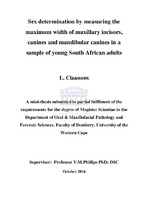Sex determination by measuring the maximum width of maxillary incisors, canines and mandibular canines in a sample of young South African adults
Abstract
Sex determination of human remains is often a dilemma for forensic experts due to the decomposing factor, or, if only part of a body is found. The analysis of DNA is thought to be the most accurate method for sex determination, but the cost and time involvement usually causes a delay in the identification process and in some cases, DNA is not obtainable due to the state of decomposition or contamination. Sexual dimorphism refers to the difference in shape, form or appearance between male and females in the same species. It can also be described as the systematic difference between individuals of different sex in the same species. Dimorphism in the human skeletal system and dentition is well establish. It is generally assumed that the male dentition is larger than the female dentition. In this study, the mesio-distal width of the maxillary incisors and canines, as well as the mandibular canines were measured. Orthodontic study models were used in this study, 50 males and 50 females, in which the sizes of the maxillary central incisors, maxillary lateral incisors, and maxillary and mandibular canines were measured. The results showed that the sizes of the maxillary and the mandibular canines were significantly more accurate in determining sexual dimorphism than the incisors. The logistic regression model, using tooth 13 and 33, provides prediction accuracy of 52% for males and 74% for females.

